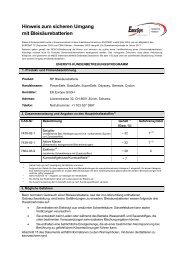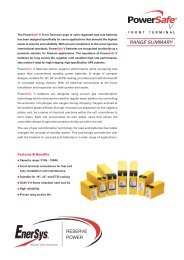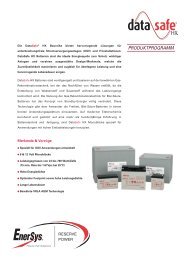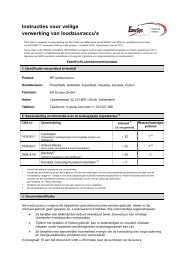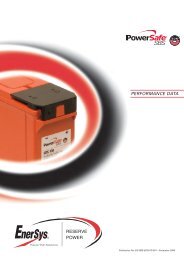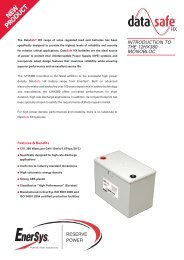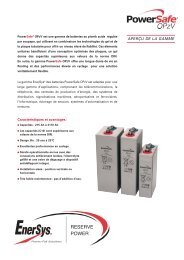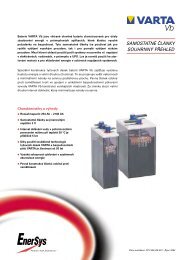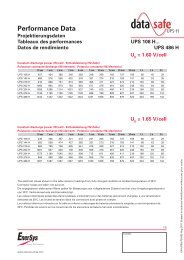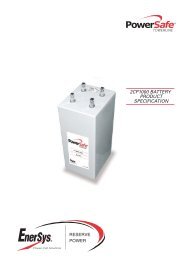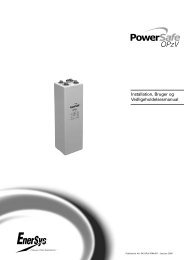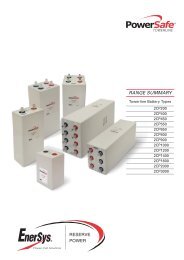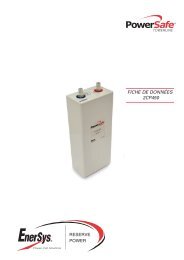Powersafe® Opzv - Enersys - EMEA
Powersafe® Opzv - Enersys - EMEA
Powersafe® Opzv - Enersys - EMEA
You also want an ePaper? Increase the reach of your titles
YUMPU automatically turns print PDFs into web optimized ePapers that Google loves.
Operation Guide > PowerSafe ® OPzV <<br />
2.2 Discharging<br />
As a rule, installations will be equipped with a regulator whose voltage threshold values will protect against deep discharge:<br />
10h<br />
Discharge<br />
120h 240h<br />
Low voltage alarm per cell 1.92 1.92V 1.95V<br />
Disconnect voltage per cell 1.80 1.85V 1.90V<br />
2.3 Setting Charging Voltages<br />
In order to ensure optimum recharge, the following setting charge disconnect and restart voltages can be applied:<br />
Temperature<br />
-20 to 0ºC 0 to 20ºC 20 to 35ºC > 35ºC<br />
Low recharge-restart voltage<br />
(Vpc)<br />
2.35V 2.30V 2.30V 2.25V<br />
High recharge-disconnect<br />
voltage (Vpc)<br />
2.55V 2.45V 2.40V 2.35V<br />
3 SERVICE LIFE<br />
Under normal operating conditions, the battery lifetime largely depends on the temperature and depths of discharge.<br />
Infl uence of temperature<br />
See curve page 3.<br />
Example of an <strong>Powersafe®</strong> OPzV battery cycling with 20% daily:<br />
Average temperature<br />
of cells<br />
Number of cycles at<br />
25°C<br />
Compensation<br />
coefficient<br />
Estimated average<br />
number of cycles at<br />
average temperature<br />
25ºC 5500 1 5500<br />
30ºC 5500 0.83 4565<br />
35ºC 5500 0.71 3905<br />
Infl uence of depth of discharge<br />
See curve (item 2.1), relative to number of cycles according to DOD at 25°C.<br />
Example of an PowerSafe® OPzV battery at 25°C:<br />
Daily depth<br />
of discharge<br />
Number of cycles at<br />
25°C<br />
Compensation<br />
coefficient<br />
15 7333 > 18 years<br />
20 5500 >15 years<br />
4 MAINTENANCE CHECKS DATA RECORDING<br />
PowerSafe ® OPzV cell are VRLA batteries and do not have to be topped up.<br />
• Do not open the valve. Opening could cause lasting damage to the battery and is prohibited.<br />
• The containers and lids should be kept dry and free from dust. Cleaning must be undertaken with a damped cotton<br />
cloth without additives and without manmade fi bres or addition of cleaning agents, never use abrasives or solvents.<br />
Avoid electrostatic charging.<br />
• Every 6 months, check total voltage at battery terminals and battery room temperature.<br />
• Keep a logbook in which the measured values can be noted as well as time and date of each event like discharge<br />
tests etc.<br />
7



